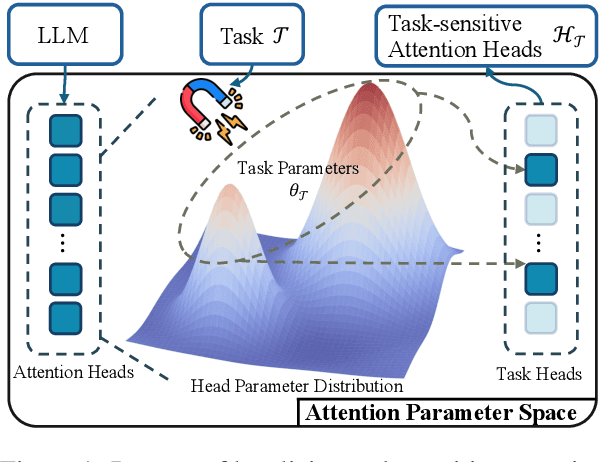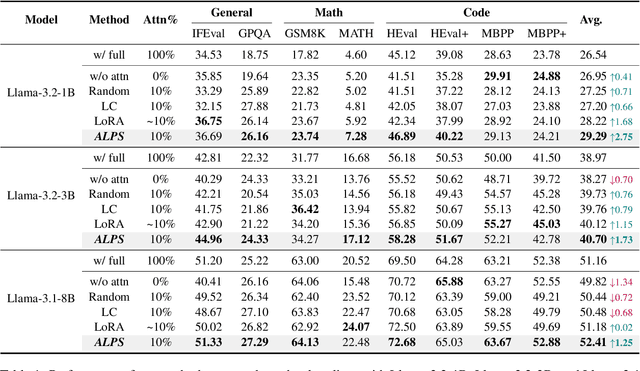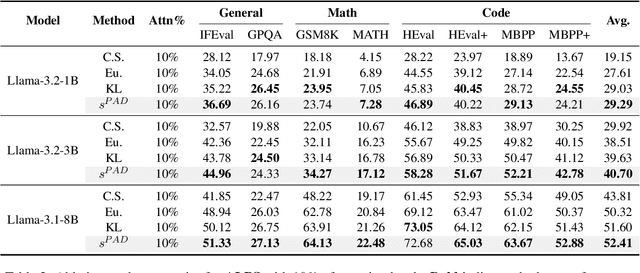Junbo Zhao
Jake
Every Step Evolves: Scaling Reinforcement Learning for Trillion-Scale Thinking Model
Oct 21, 2025Abstract:We present Ring-1T, the first open-source, state-of-the-art thinking model with a trillion-scale parameter. It features 1 trillion total parameters and activates approximately 50 billion per token. Training such models at a trillion-parameter scale introduces unprecedented challenges, including train-inference misalignment, inefficiencies in rollout processing, and bottlenecks in the RL system. To address these, we pioneer three interconnected innovations: (1) IcePop stabilizes RL training via token-level discrepancy masking and clipping, resolving instability from training-inference mismatches; (2) C3PO++ improves resource utilization for long rollouts under a token budget by dynamically partitioning them, thereby obtaining high time efficiency; and (3) ASystem, a high-performance RL framework designed to overcome the systemic bottlenecks that impede trillion-parameter model training. Ring-1T delivers breakthrough results across critical benchmarks: 93.4 on AIME-2025, 86.72 on HMMT-2025, 2088 on CodeForces, and 55.94 on ARC-AGI-v1. Notably, it attains a silver medal-level result on the IMO-2025, underscoring its exceptional reasoning capabilities. By releasing the complete 1T parameter MoE model to the community, we provide the research community with direct access to cutting-edge reasoning capabilities. This contribution marks a significant milestone in democratizing large-scale reasoning intelligence and establishes a new baseline for open-source model performance.
MultiEdit: Advancing Instruction-based Image Editing on Diverse and Challenging Tasks
Sep 18, 2025Abstract:Current instruction-based image editing (IBIE) methods struggle with challenging editing tasks, as both editing types and sample counts of existing datasets are limited. Moreover, traditional dataset construction often contains noisy image-caption pairs, which may introduce biases and limit model capabilities in complex editing scenarios. To address these limitations, we introduce MultiEdit, a comprehensive dataset featuring over 107K high-quality image editing samples. It encompasses 6 challenging editing tasks through a diverse collection of 18 non-style-transfer editing types and 38 style transfer operations, covering a spectrum from sophisticated style transfer to complex semantic operations like person reference editing and in-image text editing. We employ a novel dataset construction pipeline that utilizes two multi-modal large language models (MLLMs) to generate visual-adaptive editing instructions and produce high-fidelity edited images, respectively. Extensive experiments demonstrate that fine-tuning foundational open-source models with our MultiEdit-Train set substantially improves models' performance on sophisticated editing tasks in our proposed MultiEdit-Test benchmark, while effectively preserving their capabilities on the standard editing benchmark. We believe MultiEdit provides a valuable resource for advancing research into more diverse and challenging IBIE capabilities. Our dataset is available at https://huggingface.co/datasets/inclusionAI/MultiEdit.
CrowdAgent: Multi-Agent Managed Multi-Source Annotation System
Sep 17, 2025Abstract:High-quality annotated data is a cornerstone of modern Natural Language Processing (NLP). While recent methods begin to leverage diverse annotation sources-including Large Language Models (LLMs), Small Language Models (SLMs), and human experts-they often focus narrowly on the labeling step itself. A critical gap remains in the holistic process control required to manage these sources dynamically, addressing complex scheduling and quality-cost trade-offs in a unified manner. Inspired by real-world crowdsourcing companies, we introduce CrowdAgent, a multi-agent system that provides end-to-end process control by integrating task assignment, data annotation, and quality/cost management. It implements a novel methodology that rationally assigns tasks, enabling LLMs, SLMs, and human experts to advance synergistically in a collaborative annotation workflow. We demonstrate the effectiveness of CrowdAgent through extensive experiments on six diverse multimodal classification tasks. The source code and video demo are available at https://github.com/QMMMS/CrowdAgent.
Merge-of-Thought Distillation
Sep 10, 2025Abstract:Efficient reasoning distillation for long chain-of-thought (CoT) models is increasingly constrained by the assumption of a single oracle teacher, despite practical availability of multiple candidate teachers and growing CoT corpora. We revisit teacher selection and observe that different students have different "best teachers," and even for the same student the best teacher can vary across datasets. Therefore, to unify multiple teachers' reasoning abilities into student with overcoming conflicts among various teachers' supervision, we propose Merge-of-Thought Distillation (MoT), a lightweight framework that alternates between teacher-specific supervised fine-tuning branches and weight-space merging of the resulting student variants. On competition math benchmarks, using only about 200 high-quality CoT samples, applying MoT to a Qwen3-14B student surpasses strong models including DEEPSEEK-R1, QWEN3-30B-A3B, QWEN3-32B, and OPENAI-O1, demonstrating substantial gains. Besides, MoT consistently outperforms the best single-teacher distillation and the naive multi-teacher union, raises the performance ceiling while mitigating overfitting, and shows robustness to distribution-shifted and peer-level teachers. Moreover, MoT reduces catastrophic forgetting, improves general reasoning beyond mathematics and even cultivates a better teacher, indicating that consensus-filtered reasoning features transfer broadly. These results position MoT as a simple, scalable route to efficiently distilling long CoT capabilities from diverse teachers into compact students.
Grove MoE: Towards Efficient and Superior MoE LLMs with Adjugate Experts
Aug 11, 2025Abstract:The Mixture of Experts (MoE) architecture is a cornerstone of modern state-of-the-art (SOTA) large language models (LLMs). MoE models facilitate scalability by enabling sparse parameter activation. However, traditional MoE architecture uses homogeneous experts of a uniform size, activating a fixed number of parameters irrespective of input complexity and thus limiting computational efficiency. To overcome this limitation, we introduce Grove MoE, a novel architecture incorporating experts of varying sizes, inspired by the heterogeneous big.LITTLE CPU architecture. This architecture features novel adjugate experts with a dynamic activation mechanism, enabling model capacity expansion while maintaining manageable computational overhead. Building on this architecture, we present GroveMoE-Base and GroveMoE-Inst, 33B-parameter LLMs developed by applying an upcycling strategy to the Qwen3-30B-A3B-Base model during mid-training and post-training. GroveMoE models dynamically activate 3.14-3.28B parameters based on token complexity and achieve performance comparable to SOTA open-source models of similar or even larger size.
SPA++: Generalized Graph Spectral Alignment for Versatile Domain Adaptation
Aug 07, 2025Abstract:Domain Adaptation (DA) aims to transfer knowledge from a labeled source domain to an unlabeled or sparsely labeled target domain under domain shifts. Most prior works focus on capturing the inter-domain transferability but largely overlook rich intra-domain structures, which empirically results in even worse discriminability. To tackle this tradeoff, we propose a generalized graph SPectral Alignment framework, SPA++. Its core is briefly condensed as follows: (1)-by casting the DA problem to graph primitives, it composes a coarse graph alignment mechanism with a novel spectral regularizer toward aligning the domain graphs in eigenspaces; (2)-we further develop a fine-grained neighbor-aware propagation mechanism for enhanced discriminability in the target domain; (3)-by incorporating data augmentation and consistency regularization, SPA++ can adapt to complex scenarios including most DA settings and even challenging distribution scenarios. Furthermore, we also provide theoretical analysis to support our method, including the generalization bound of graph-based DA and the role of spectral alignment and smoothing consistency. Extensive experiments on benchmark datasets demonstrate that SPA++ consistently outperforms existing cutting-edge methods, achieving superior robustness and adaptability across various challenging adaptation scenarios.
Ring-lite: Scalable Reasoning via C3PO-Stabilized Reinforcement Learning for LLMs
Jun 18, 2025Abstract:We present Ring-lite, a Mixture-of-Experts (MoE)-based large language model optimized via reinforcement learning (RL) to achieve efficient and robust reasoning capabilities. Built upon the publicly available Ling-lite model, a 16.8 billion parameter model with 2.75 billion activated parameters, our approach matches the performance of state-of-the-art (SOTA) small-scale reasoning models on challenging benchmarks (e.g., AIME, LiveCodeBench, GPQA-Diamond) while activating only one-third of the parameters required by comparable models. To accomplish this, we introduce a joint training pipeline integrating distillation with RL, revealing undocumented challenges in MoE RL training. First, we identify optimization instability during RL training, and we propose Constrained Contextual Computation Policy Optimization(C3PO), a novel approach that enhances training stability and improves computational throughput via algorithm-system co-design methodology. Second, we empirically demonstrate that selecting distillation checkpoints based on entropy loss for RL training, rather than validation metrics, yields superior performance-efficiency trade-offs in subsequent RL training. Finally, we develop a two-stage training paradigm to harmonize multi-domain data integration, addressing domain conflicts that arise in training with mixed dataset. We will release the model, dataset, and code.
RealHiTBench: A Comprehensive Realistic Hierarchical Table Benchmark for Evaluating LLM-Based Table Analysis
Jun 16, 2025Abstract:With the rapid advancement of Large Language Models (LLMs), there is an increasing need for challenging benchmarks to evaluate their capabilities in handling complex tabular data. However, existing benchmarks are either based on outdated data setups or focus solely on simple, flat table structures. In this paper, we introduce RealHiTBench, a comprehensive benchmark designed to evaluate the performance of both LLMs and Multimodal LLMs (MLLMs) across a variety of input formats for complex tabular data, including LaTeX, HTML, and PNG. RealHiTBench also includes a diverse collection of tables with intricate structures, spanning a wide range of task types. Our experimental results, using 25 state-of-the-art LLMs, demonstrate that RealHiTBench is indeed a challenging benchmark. Moreover, we also develop TreeThinker, a tree-based pipeline that organizes hierarchical headers into a tree structure for enhanced tabular reasoning, validating the importance of improving LLMs' perception of table hierarchies. We hope that our work will inspire further research on tabular data reasoning and the development of more robust models. The code and data are available at https://github.com/cspzyy/RealHiTBench.
Prompt Candidates, then Distill: A Teacher-Student Framework for LLM-driven Data Annotation
Jun 04, 2025Abstract:Recently, Large Language Models (LLMs) have demonstrated significant potential for data annotation, markedly reducing the labor costs associated with downstream applications. However, existing methods mostly adopt an aggressive strategy by prompting LLM to determine a single gold label for each unlabeled sample. Due to the inherent uncertainty within LLMs, they often produce incorrect labels for difficult samples, severely compromising the data quality for downstream applications. Motivated by ambiguity aversion in human behaviors, we propose a novel candidate annotation paradigm wherein large language models are encouraged to output all possible labels when incurring uncertainty. To ensure unique labels are provided for downstream tasks, we develop a teacher-student framework CanDist that distills candidate annotations with a Small Language Model (SLM). We further provide a rigorous justification demonstrating that distilling candidate annotations from the teacher LLM offers superior theoretical guarantees compared to directly using single annotations. Extensive experiments across six text classification tasks validate the effectiveness of our proposed method. The source code is available at https://github.com/MingxuanXia/CanDist.
ALPS: Attention Localization and Pruning Strategy for Efficient Alignment of Large Language Models
May 24, 2025



Abstract:Aligning general-purpose large language models (LLMs) to downstream tasks often incurs significant costs, including constructing task-specific instruction pairs and extensive training adjustments. Prior research has explored various avenues to enhance alignment efficiency, primarily through minimal-data training or data-driven activations to identify key attention heads. However, these approaches inherently introduce data dependency, which hinders generalization and reusability. To address this issue and enhance model alignment efficiency, we propose the \textit{\textbf{A}ttention \textbf{L}ocalization and \textbf{P}runing \textbf{S}trategy (\textbf{ALPS})}, an efficient algorithm that localizes the most task-sensitive attention heads and prunes by restricting attention training updates to these heads, thereby reducing alignment costs. Experimental results demonstrate that our method activates only \textbf{10\%} of attention parameters during fine-tuning while achieving a \textbf{2\%} performance improvement over baselines on three tasks. Moreover, the identified task-specific heads are transferable across datasets and mitigate knowledge forgetting. Our work and findings provide a novel perspective on efficient LLM alignment.
 Add to Chrome
Add to Chrome Add to Firefox
Add to Firefox Add to Edge
Add to Edge